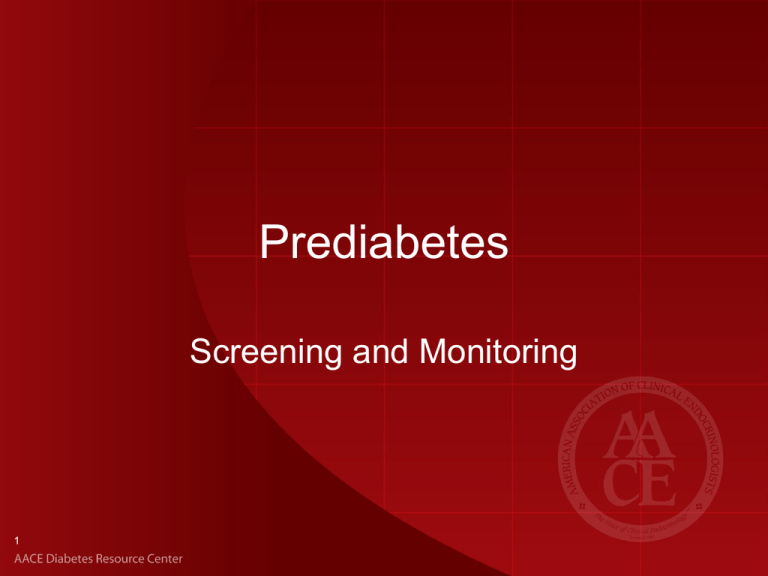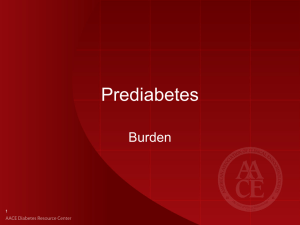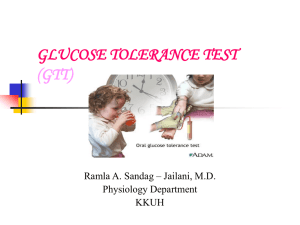
Prediabetes
Screening and Monitoring
1
Prediabetes
• Epidemiologic evidence suggests that the
complications of T2DM begin early in the
progression from NGT to frank diabetes
• Prediabetes and diabetes are conditions in
which early detection is appropriate, because:
– Duration of hyperglycemia is a predictor of
adverse outcomes
– There are effective interventions to prevent
disease progression and to reduce complications
2
NGT, normal glucose tolerance; T2DM, type 2 diabetes mellitus.
Garber AJ et al. Endocr Pract. 2008;14:933-946.
Coronary Heart Disease in
Individuals With Diabetes or
Prediabetes
• Substantial prevalence of diabetes and
prediabetes among adults with CHD
– Likely underestimated because of suboptimal
screening
• Clinical performance measures recommend
that nondiabetic patients with CHD be screened
for diabetes every 3 years
– 1 of 4 nondiabetic adults with CHD reported not
being screened for diabetes over the past 3 years
3
CHD, coronary heart disease.
Kilmer G, et al. Am J Prev Med. 2011;40:159-165.
Risk Factors for Prediabetes
•
•
•
•
•
•
•
•
4
Cardiovascular disease
Family history of diabetes
Hypertension
Dyslipidemia
Sedentary lifestyle
Overweight or obese
Non-Caucasian ancestry
Previously identified IGT,
IFG, and/or metabolic
syndrome
• History of gestational
diabetes
• Delivery of a large baby
(>9 lbs/4 kg)
• Polycystic ovary disease
• Treatment for schizophrenia
or bipolar disease
IFG, impaired fasting glucose; IGT, impaired glucose tolerance.
Garber AJ, et al. Endocr Pract. 2008;14:933-946; Handelsman Y, et al. Endocr Pract. 2011;17(suppl 2):1-53.
Normal Fasting Plasma Glucose
and Risk of T2DM Diagnosis
• Patients with normal fasting plasma glucose
and any of the following comorbidities are at
increased risk of developing diabetes:
–
–
–
–
–
Obesity
Hypertension
Low HDL cholesterol
High triglycerides
Smoking
• Closer surveillance for diabetes development
might be warranted in these patients
5
T2DM, type 2 diabetes mellitus.
Nichols GA, et al. Am J Med 2008;121:519-524.
Relative Risk of Developing
Diabetes
FPG (mg/dL)
≤86
87-90
91-99
8.23
(3.6-19.0)
9
Hazard ratio (95% CI)
8
7
5.26
(2.5-11.3)
6
5
4
3
1.76
(0.8-3.7)
2
1
2.65
(1.2-6.1)
2.42
(1.3-4.4)
1
0
≥150
<150
Triglyceride level (mg/dL)
6
CI, confidence interval; FPG, fasting plasma glucose.
Tirosh A, et al. N Engl J Med. 2005;353:1454-1462.
Relative Risk of Developing
Diabetes
FPG (mg/dL)
≤86
87-90
91-99
8.29
7.78 (3.8-17.8)
(3.2-18.7)
9
Hazard ratio (95% CI)
8
7
6
4.77
(2.3-9.7)
5
4
3
2
1
1
0.75
(0.2-2.7)
1.79
(0.8-4.1)
1.99
(0.9-4.3)
2.75
(1.2-6.3)
3.42
(1.4-3.5)
0
<25
25-29.9
≥30
Body mass index (kg/m2)
7
CI, confidence interval; FPG, fasting plasma glucose.
Tirosh A, et al. N Engl J Med. 2005;353:1454-1462.
Interventional Criteria for Prediabetes
• IFG: FPG 100-125 mg/dL
• IGT: 2-hour PPG 140-199 mg/dL
– In patients with IFG, a 2-hour OGTT may further clarify the level of
risk while also detecting undiagnosed diabetes
– Patients with impaired glucose metabolism identified by 2-hour
OGTT were greater in number than patients discovered by routine
FPG
• Metabolic syndrome diagnosed by the NCEP criteria should be
considered a prediabetes equivalent
– The metabolic syndrome predicts future diabetes better than IFG
– 3 of 5 metabolic syndrome criteria are sufficient; recent evidence
suggests even 2 of 5 metabolic syndrome criteria may be adequate
8
FPG, fasting plasma glucose; IFG, impaired fasting glucose; IGT, impaired glucose tolerance; OGTT, oral glucose
tolerance test; NCEP, national cholesterol estrogen program.
Handelsman Y, et al. Endocr Pract. 2011;17(suppl 2):1-53; Garber AJ, et al. Endocr Pract. 2008;14:933-946.
Clinical Identification of
Metabolic Syndrome
Risk Factor
Definition
Abdominal obesity
Men
Women
Waist circumference†
>102 cm (>40 in)
>88 cm (>35 in)
Triglycerides
≥150 mg/dL
HDL cholesterol
Men
Women
<40 mg/dL
<50 mg/dL
Blood pressure
≥130/85 mmHg
Fasting glucose
≥110 mg/dL
Note: The ATP III panel did not find adequate evidence to recommend routine measurement of insulin resistance
(eg, plasma insulin), proinflammatory state (eg, high-sensitivity C-reactive protein), or prothrombotic state (eg,
fibrinogen or PAI-1) in the diagnosis of the metabolic syndrome.
† Some male persons can develop multiple metabolic risk factors when the waist circumference is only marginally
increased, eg, 94-102 cm (37-39 in). Such persons may have a strong genetic contribution to insulin resistance.
They should benefit from changes in life habits, similarly to men with categorical increases in waist
circumference.
9
ATP III, Adult Treatment Panel III; NCEP, National Cholesterol Education Panel; PAI-1, plasminogen activator inhibitor-1.
NCEP ATP III Final Report. NIH, NHLBI. 2002. Publication No. 02-5215.
Prevalence of Metabolic
Syndrome*
National Health and Nutrition Examination Survey
2009-2010
Prevalence (%)
Men
10
40
35
30
25
20
15
10
5
0
Women
Both sexes
34.8
31.9
28.5
22.9
20.3
21.8
24.5
23.7
22.7
19.0
21.8
White
Black
Mexican American
Total
(n=1169)
(n=384)
(n=481)
(n=2034)
22.9
*Defined as presence of ≥3 risk factors meeting
National Cholesterol Education Panel Adult Treatment Panel III (NCEP ATP III) criteria.
Beltrán-Sánchez H, et al. J Am Coll Cardiol. 2013;62:697-703.
Screening and Diagnosing
Prediabetes
Normal
Prediabetes
Diabetes
<100 mg/dL
IFG 100-125 mg/dL
≥126 mg/dL
(<5.5 mol/L)
(5.5-6.9 mmol/L)
(7 mmol/L)
<140 mg/dL
IGT140-199 mg/dL
≥200 mg/dL
(<7.7 mmol/L)
(7.8-11 mmol/L)
(≥11 mmol/L)
≤5.4%
5.5% to 6.4%
≥6.5%
Fasting Glucose
Post-challenge
glucose (2 hours
after 75g glucose
intake)
A1C
11
IFG, impaired fasting glucose; IGT, impaired glucose tolerance.
Handelsman Y, et al. Endocr Pract. 2011;17(suppl 2):1-53.
Prediabetes Screening and Monitoring
DIABETES RISK SCORES
12
Finnish Diabetes Risk Score
(FINDRISC)
• Risk assessment tool based on random
samples of patients 35-64 years of age,
followed for 5 years
– 1987 cohort (n=4746)
– 1992 cohort (n=4615)
• Score range: 0-26
– Score ≥9 predicts development of drug-treated
diabetes within 10 years
• Sensitivity 0.81 (1992 cohort)
• Specificity 0.76 (1992 cohort)
• Predictive value = 0.05 (1992 cohort)
13
Lindstrom J, Tuomilehto J. Diabetes Care. 2003;26:725-731.
FINDRISC Scores and Abnormal
Glucose Tolerance
14
AGT prevalence (%)
Diabetes prevalence (%)
Prevalence of Diabetes and Abnormal Glucose
Tolerance in Finnish Population (N=4622)
AGT, abnormal glucose tolerance; FINDRISC, Finnish Diabetes Risk Score.
Saaristo T, et al. Diabetes Vasc Dis Res. 2005;2:67-72.
Finnish Diabetes Risk Score
(FINDRISC)
Question
Score
Age (years)
Score
Hypertension medication
45-54
2
Yes
55-64
3
History of blood glucose elevations
≥65
4
Yes
BMI (kg/m2)
2
5
Family history of T1 or T2DM
25-30
1
2nd degree relative
3
≥30
3
1st degree relative
5
Total (maximum)
26
Waist circumference (cm)
94-102 (men), 80-88 (women)
3
>102 (men), >88 (women)
4
Physical activity, <30 min per day
No
2
Consumption of vegetables and fruit
Not every day
15
Question
1
Total Risk
Score
Risk of developing T2DM in
10 years
<7
1%
7-11
4%
12-14
17%
15-20
33%
≥20
50%
Finnish Diabetes Association. Available at:
http://www.diabetes.fi/files/1100/Type2diabetesRiskTest_.jpg.
ADA Diabetes Risk Score
• Risk assessment tool based on NHANES
2006 cohort ≥20 years of age (N=5258)
and validated with ARIC and CHS cohorts
(N=19,728 combined)
• Score range: 0-10
– Score ≥5 predicts undiagnosed T2DM
• Sensitivity 0.79
• Specificity 0.67
• Predictive value = 0.10
16
ARIC, Atherosclerosis Risk in Communities; CHS, Cardiovascular Health Study;
NHANES, National Health and Nutrition Examination Survey.
Ban H, et al. Ann Intern Med. 2009;151:775-783.
ADA Risk Scores and Prevalence
of Undiagnosed Diabetes
Undiagnosed diabetes
prevalence (%)
30
25
20
NHANES
15
ARIC/CHS
10
5
0
-1
0
1
2
3
4
5
6
7
8
9
Diabetes risk score
17
AGT, abnormal glucose tolerance.
Ban H, et al. Ann Intern Med. 2009;151:775-783.
ADA Diabetes Risk Score
Question
Score
Age (years)
Score
Physical activity
40-49
1
No
50-59
2
BMI
≥60
3
25-30
1
30-40
2
Sex
1
Male
1
≥40
3
Woman with history of gestational
DM
1
Total (maximum)
10
Family history of T1 or T2DM
1st degree relative
1
Hypertension diagnosis
Yes
18
Question
1
Total Risk
Score
Risk of developing T2DM in
10 years
≥4
High risk of having
prediabetes or diabetes
≥5
High risk of having diabetes
Ban H, et al. Ann Intern Med. 2009;151:775-783.
American Diabetes Association. Available at:
http://www.diabetes.org/assets/pdfs/at-risk/risk-test-paper-version.pdf.









